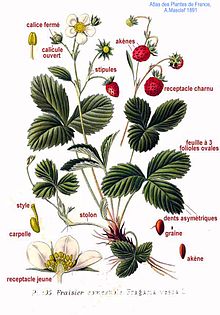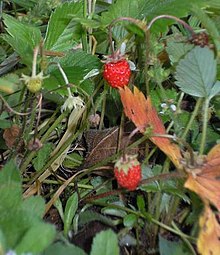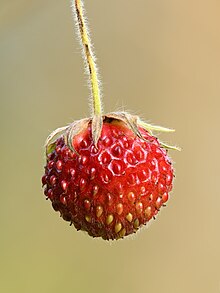| Revision as of 03:20, 27 November 2022 editInternetArchiveBot (talk | contribs)Bots, Pending changes reviewers5,382,173 edits Rescuing 2 sources and tagging 0 as dead.) #IABot (v2.0.9.2← Previous edit | Latest revision as of 10:35, 11 July 2024 edit undoPeter coxhead (talk | contribs)Autopatrolled, Extended confirmed users, Page movers, Pending changes reviewers, Rollbackers, Template editors204,251 editsm Reverted edit by 208.87.235.180 (talk) to last version by AnomieBOTTag: Rollback | ||
| (24 intermediate revisions by 17 users not shown) | |||
| Line 18: | Line 18: | ||
| ==Etymology== | ==Etymology== | ||
| The genus name {{lang|la|{{linktext|Fragaria}}}} derives from {{lang|la|{{linktext|fragum}}}} ("]") and {{lang|la|{{linktext|-aria}}}}, a suffix used to create feminine nouns and ]s. The Latin name is thought in turn to derive from a ] root meaning "]", either ''*dʰreh₂ǵ-'' or ''*sróh₂gs''.<ref>{{cite book |last1=De Vaan |first1=Michiel |title=Etymological Dictionary of Latin and the other Italic Languages |date=2008 |publisher=Brill |isbn=9789004167971 |page=239}}</ref> The genus name is sometimes ] from {{lang|la|{{linktext|fragro}}}} ("to be fragrant, to reek").{{cn|date=January 2024}} | |||
| The Latin name derives from the verb '']'', referring to the aroma of the fruit. | |||
| The English word is found in ] as ''streawberige''.<ref>''Ðeós wyrt ðe man fraga and óðrum naman streáwbergean nemneþ'': Anglo-Saxon Leechdom</ref> It is commonly thought that strawberries get their name from straw being used as a ] in cultivating the plants, though it has been suggested that the word is possibly derived from "strewn berry" in reference to the runners that "strew" or "stray away" from the base of the plants. ''Streaw'' in Old English means 'straw', but also ''streawian'' means 'to strew', from the same root.<ref>: ]</ref> David Mikkelson argues that "the word 'strawberry' has been part of the English language for at least a thousand years, well before strawberries were cultivated as garden or farm edibles."<ref>{{cite web|url=http://www.snopes.com/language/notthink/strawberry.asp |title=Etymology of Strawberry |website=Snopes.com |access-date=2013-05-08}}</ref><ref>{{aut|Darrow, G.M.}} (1966). {{Webarchive|url=https://web.archive.org/web/20130826020754/http://www.nal.usda.gov/pgdic/Strawberry/darpubs.htm |date=2013-08-26 }} 3. Early History of the Strawberry: 16</ref> | The English word is found in ] as ''streawberige''.<ref>''Ðeós wyrt ðe man fraga and óðrum naman streáwbergean nemneþ'': Anglo-Saxon Leechdom</ref> It is commonly thought that strawberries get their name from straw being used as a ] in cultivating the plants, though it has been suggested that the word is possibly derived from "strewn berry" in reference to the runners that "strew" or "stray away" from the base of the plants. ''Streaw'' in Old English means 'straw', but also ''streawian'' means 'to strew', from the same root.<ref>: ]</ref> David Mikkelson argues that "the word 'strawberry' has been part of the English language for at least a thousand years, well before strawberries were cultivated as garden or farm edibles."<ref>{{cite web|url=http://www.snopes.com/language/notthink/strawberry.asp |title=Etymology of Strawberry |website=Snopes.com |date=5 October 2003 |access-date=2013-05-08}}</ref><ref>{{aut|Darrow, G.M.}} (1966). {{Webarchive|url=https://web.archive.org/web/20130826020754/http://www.nal.usda.gov/pgdic/Strawberry/darpubs.htm |date=2013-08-26 }} 3. Early History of the Strawberry: 16</ref> | ||
| ==Classification== | ==Classification== | ||
| There are more than 20 different ''Fragaria'' species worldwide. A number of other species have been proposed, some of which are now recognized as subspecies.<ref>{{cite web |url=https://npgsweb.ars-grin.gov/gringlobal/taxon/taxonomysimple.aspx?Fragaria |title=Species records in the database (for the query: '''genus''' = ''Fragaria'') |publisher= |
There are more than 20 different ''Fragaria'' species worldwide. A number of other species have been proposed, some of which are now recognized as subspecies.<ref>{{cite web |url=https://npgsweb.ars-grin.gov/gringlobal/taxon/taxonomysimple.aspx?Fragaria |title=Species records in the database (for the query: '''genus''' = ''Fragaria'') |publisher=U.S. National Plant Germplasm System |access-date=2017-08-24}}</ref> One key to the classification of strawberry species is that they vary in the number of ]s. They all have seven basic ''types'' of chromosomes, but exhibit different ]. Some species are diploid, having two sets of the seven chromosomes (14 chromosomes total), but others are tetraploid (four sets, 28 chromosomes total), hexaploid (six sets, 42 chromosomes total), octoploid (eight sets, 56 chromosomes total), or decaploid (ten sets, 70 chromosomes total). | ||
| As a rough rule (with exceptions), strawberry species with more chromosomes tend to be more robust and produce larger plants with larger berries.<ref>Darrow, George M. ''The Strawberry: History, Breeding and Physiology''. New York. Holt, Rinehart and Winston, 1966. {{Webarchive|url=https://web.archive.org/web/20130826020754/http://www.nal.usda.gov/pgdic/Strawberry/darpubs.htm |date=2013-08-26 }}</ref> | As a rough rule (with exceptions), strawberry species with more chromosomes tend to be more robust and produce larger plants with larger berries.<ref>Darrow, George M. ''The Strawberry: History, Breeding and Physiology''. New York. Holt, Rinehart and Winston, 1966. {{Webarchive|url=https://web.archive.org/web/20130826020754/http://www.nal.usda.gov/pgdic/Strawberry/darpubs.htm |date=2013-08-26 }}</ref> | ||
| The oldest fossils confidently classifiable as ''Fragaria'' are from the ] of Poland. Fossilised ''Fragaria'' achenes are also known from the ] of China.<ref>{{Cite journal | |
The oldest fossils confidently classifiable as ''Fragaria'' are from the ] of Poland. Fossilised ''Fragaria'' achenes are also known from the ] of China.<ref>{{Cite journal |last1=Huang |first1=Yong-Jiang |last2=Zhu |first2=Hai |last3=Momohara |first3=Arata |last4=Jia |first4=Lin-Bo |last5=Zhou |first5=Zhe-Kun |date=March 2019 |title=Fruit fossils of Rosoideae (Rosaceae) from the late Pliocene of northwestern Yunnan, Southwest China |journal=Journal of Systematics and Evolution |language=en |volume=57 |issue=2 |pages=180–189 |doi=10.1111/jse.12443 |s2cid=89751967 |issn=1674-4918|doi-access=free }}</ref> | ||
| ===Diploid species=== | ===Diploid species=== | ||
| Line 36: | Line 36: | ||
| ]'' fruit photographed in ], ]]] | ]'' fruit photographed in ], ]]] | ||
| *] <small>Duchesne</small> - ''F. vesca'' × ''F. viridis'' (Europe) | * ] <small>Duchesne</small> - ''F. vesca'' × ''F. viridis'' (Europe) | ||
| *'']'' <small>]</small> (China) | *'']'' <small>]</small> (China) | ||
| *'']'' <small>Losinsk</small> (China) | |||
| *'']'' <small>J.Gay</small> (Himalayas) | *'']'' <small>J.Gay</small> (Himalayas) | ||
| * '']'' Jia J. Lei (China) | * '']'' Jia J. Lei (China) | ||
| *'']'' <small>Losinsk.</small> (China) | *'']'' <small>Losinsk.</small> (China) | ||
| *'']'' <small>Makino</small> ( |
*'']'' <small>Makino</small> (Taiwan) | ||
| *'']'' <small>Makino</small> (East Russia, Japan) | |||
| *'']'' <small>Staudt</small> (China) | *'']'' <small>Staudt</small> (China) | ||
| *'']'' <small>Schlecht. ex J.Gay</small> (] and ]) | *'']'' <small>Schlecht. ex J.Gay</small> (] and ]) | ||
| *'']'' <small>]</small> ( |
*'']'' <small>]</small> (Korea, Japan) | ||
| *'']'' <small>] ex ]</small> (]) | *'']'' <small>] ex ]</small> (]) | ||
| *'']'' <small> Losinsk.</small> (China) | *'']'' <small> Losinsk.</small> (China) | ||
| *'']'' <small>]</small> - woodland strawberry (]) | *'']'' <small>]</small> - woodland strawberry (]) | ||
| *'']'' <small>]</small> ( |
*'']'' <small>]</small> (Europe, Central Asia) | ||
| ⚫ | *'']'' <small> |
||
| ===Tetraploid species=== | ===Tetraploid species=== | ||
| ⚫ | * '']'' <small>Losinsk.</small> (northern China) | ||
| * ] <small>(Bach) Beck</small> (Europe) | |||
| *'']'' <small>Cardot</small> (China) | *'']'' <small>Cardot</small> (China) | ||
| *'']'' <small>Losinsk.</small> (Eastern Asia, Eastern Siberia) | *'']'' <small>Losinsk.</small> (Eastern Asia, Eastern Siberia) | ||
| *'']'' Staudt & Dickoré (China) | |||
| ===Pentaploid hybrids=== | ===Pentaploid hybrids=== | ||
| Line 73: | Line 78: | ||
| ===Decaploid species and hybrids=== | ===Decaploid species and hybrids=== | ||
| *'']'' <small>K.E. Hummer</small> (Cascade Mountains in ])<ref>{{cite journal |author-last=Hummer |author-first=K.E. |date=2012 |url=http://www.ars.usda.gov/research/publications/publications.htm?seq_no_115=276470 |title=A new species of Fragaria (Roseaceae) from Oregon |journal=Journal of the Botanical Research Institute of Texas |volume=6 |issue=1 |pages=9–15 |access-date=2012-06-10}}</ref> | *'']'' <small>K.E. Hummer</small> (Cascade Mountains in ])<ref>{{cite journal |author-last=Hummer |author-first=K.E. |date=2012 |url=http://www.ars.usda.gov/research/publications/publications.htm?seq_no_115=276470 |title=A new species of Fragaria (Roseaceae) from Oregon |journal=Journal of the Botanical Research Institute of Texas |volume=6 |issue=1 |pages=9–15 |access-date=2012-06-10}}</ref> | ||
| *'']'' <small> |
*'']'' <small>Staudt</small> - Iturup strawberry (], ]) | ||
| *] | *] | ||
| *'']'' | *'']'' | ||
| === Polyploidy unknown === | |||
| * '']'' <small>S.S.Ying</small> (Taiwan) | |||
| ===Uncategorized hybrids=== | ===Uncategorized hybrids=== | ||
| Line 84: | Line 93: | ||
| ==Ecology== | ==Ecology== | ||
| A number of species of ] and ]s feed on strawberry plants |
A number of species of ] and ]s feed on strawberry plants.{{facts|date=June 2024}} | ||
| ==See also== | ==See also== | ||
| Line 99: | Line 108: | ||
| ==External links== | ==External links== | ||
| ⚫ | * from the U.S. National Plant Germplasm System website | ||
| {{Commons category}} | |||
| {{Wikispecies|Fragaria}} | |||
| ⚫ | * from the |
||
| {{fragaria}} | {{fragaria}} | ||
| Line 112: | Line 119: | ||
| ] | ] | ||
| ] | ] | ||
| ] | |||
Latest revision as of 10:35, 11 July 2024
Genus of strawberry plants This article is about the plant genus. For the most commonly cultivated strawberry, see Strawberry.
| Fragaria Temporal range: Miocene–Recent PreꞒ Ꞓ O S D C P T J K Pg N | |
|---|---|

| |
| Fragaria vesca illustration from Atlas des plantes de France 1891, by A. Masclef | |
| Scientific classification | |
| Kingdom: | Plantae |
| Clade: | Tracheophytes |
| Clade: | Angiosperms |
| Clade: | Eudicots |
| Clade: | Rosids |
| Order: | Rosales |
| Family: | Rosaceae |
| Subfamily: | Rosoideae |
| Tribe: | Potentilleae |
| Subtribe: | Fragariinae |
| Genus: | Fragaria L. |
| Species | |
|
20+ species; see text | |
Fragaria (/frəˈɡɛəri.ə/) is a genus of flowering plants in the rose family, Rosaceae, commonly known as strawberries for their edible fruits. There are more than 20 described species and many hybrids and cultivars. The most common strawberries grown commercially are cultivars of the garden strawberry, a hybrid known as Fragaria × ananassa. Strawberries have a taste that varies by cultivar, and ranges from quite sweet to rather tart. Strawberries are an important commercial fruit crop, widely grown in all temperate regions of the world.
Description
Strawberries are not berries in the botanical sense. The fleshy and edible part of the "fruit" is a receptacle, and the parts that are sometimes mistakenly called "seeds" are achenes and therefore the true botanical fruits.
Etymology
The genus name Fragaria derives from fragum ("strawberry") and -aria, a suffix used to create feminine nouns and plant names. The Latin name is thought in turn to derive from a Proto-Indo-European language root meaning "berry", either *dʰreh₂ǵ- or *sróh₂gs. The genus name is sometimes mistakenly derived from fragro ("to be fragrant, to reek").
The English word is found in Old English as streawberige. It is commonly thought that strawberries get their name from straw being used as a mulch in cultivating the plants, though it has been suggested that the word is possibly derived from "strewn berry" in reference to the runners that "strew" or "stray away" from the base of the plants. Streaw in Old English means 'straw', but also streawian means 'to strew', from the same root. David Mikkelson argues that "the word 'strawberry' has been part of the English language for at least a thousand years, well before strawberries were cultivated as garden or farm edibles."
Classification
There are more than 20 different Fragaria species worldwide. A number of other species have been proposed, some of which are now recognized as subspecies. One key to the classification of strawberry species is that they vary in the number of chromosomes. They all have seven basic types of chromosomes, but exhibit different polyploidy. Some species are diploid, having two sets of the seven chromosomes (14 chromosomes total), but others are tetraploid (four sets, 28 chromosomes total), hexaploid (six sets, 42 chromosomes total), octoploid (eight sets, 56 chromosomes total), or decaploid (ten sets, 70 chromosomes total).
As a rough rule (with exceptions), strawberry species with more chromosomes tend to be more robust and produce larger plants with larger berries.
The oldest fossils confidently classifiable as Fragaria are from the Miocene of Poland. Fossilised Fragaria achenes are also known from the Pliocene of China.
Diploid species





- Fragaria × bifera Duchesne - F. vesca × F. viridis (Europe)
- Fragaria bucharica Losinsk. (China)
- Fragaria chinensis Losinsk (China)
- Fragaria daltoniana J.Gay (Himalayas)
- Fragaria emeiensis Jia J. Lei (China)
- Fragaria gracilis Losinsk. (China)
- Fragaria hayatae Makino (Taiwan)
- Fragaria iinumae Makino (East Russia, Japan)
- Fragaria mandshurica Staudt (China)
- Fragaria nilgerrensis Schlecht. ex J.Gay (South and Southeast Asia)
- Fragaria nipponica Makino (Korea, Japan)
- Fragaria nubicola Lindl. ex Lacaita (Himalayas)
- Fragaria pentaphylla Losinsk. (China)
- Fragaria vesca L. - woodland strawberry (Northern Hemisphere)
- Fragaria viridis Duchesne (Europe, Central Asia)
Tetraploid species
- Fragaria corymbosa Losinsk. (northern China)
- Fragaria × intermedia (Bach) Beck (Europe)
- Fragaria moupinensis Cardot (China)
- Fragaria orientalis Losinsk. (Eastern Asia, Eastern Siberia)
- Fragaria tibetica Staudt & Dickoré (China)
Pentaploid hybrids
- Fragaria × bringhurstii Staudt (coast of California)
Hexaploid species
- Fragaria moschata Duchesne - musk strawberry (Europe)
Octoploid species and hybrids
- Fragaria × ananassa Duchesne ex Rozier - garden strawberry, pineapple strawberry
- Fragaria chiloensis (L.) Mill. - beach strawberry (Western Americas)
- Fragaria chiloensis subsp. chiloensis forma chiloensis
- Fragaria chiloensis subsp. chiloensis forma patagonica (Argentina, Chile)
- Fragaria chiloensis subsp. lucida (E. Vilm. ex Gay) Staudt (coast of British Columbia, Washington, Oregon, California)
- Fragaria chiloensis subsp. pacifica Staudt (coast of Alaska, British Columbia, Washington, Oregon, California)
- Fragaria chiloensis subsp. sandwicensis (Decne.) Staudt - ʻōhelo papa (Hawaiʻi)
- Fragaria virginiana Mill. - Virginia strawberry (North America)
Decaploid species and hybrids
- Fragaria cascadensis K.E. Hummer (Cascade Mountains in Oregon)
- Fragaria iturupensis Staudt - Iturup strawberry (Iturup, Kuril Islands)
- Fragaria × Comarum hybrids
- Fragaria × vescana
Polyploidy unknown
- Fragaria tayulinensis S.S.Ying (Taiwan)
Uncategorized hybrids
- 'Lipstick' (Fragaria × Comarum hybrid), red-flowered runnering ornamental, sparse small globular fruits.
- Fragaria vesca and certain other diploid species can be hybridized and produce fertile offspring (although Fragaria nilgerrensis appears less compatible).
- Fragaria moschata can hybridize with diploid species such as Fragaria viridis and Fragaria nubicola but producing a lower proportion of viable seeds.
- Fragaria moschata can hybridize with Fragaria × ananassa.
Ecology
A number of species of butterflies and moths feed on strawberry plants.
See also
- Accessory fruit
- Mock strawberry (Duchesnea/Potentilla indica) and barren strawberry (Potentilla sterilis, Waldsteinia fragarioides) are closely related species in other genera which resemble Fragaria.
- Strawberry tree (disambiguation) is a name for several trees that are unrelated to strawberry.
- The breeding of strawberries
References
- Sunset Western Garden Book, 1995: 606–07
- ^ Esau, K. 1977. Anatomy of seed plants. John Wiley and Sons, New York.
- E-Flora BC: Electronic Atlas of the Plants of British Columbia: Fragaria virginiana.
- De Vaan, Michiel (2008). Etymological Dictionary of Latin and the other Italic Languages. Brill. p. 239. ISBN 9789004167971.
- Ðeós wyrt ðe man fraga and óðrum naman streáwbergean nemneþ: Anglo-Saxon Leechdom
- Bosworth and Toller: An Anglo-Saxon Dictionary
- "Etymology of Strawberry". Snopes.com. 5 October 2003. Retrieved 2013-05-08.
- Darrow, G.M. (1966). The Strawberry: History, Breeding and Physiology Archived 2013-08-26 at the Wayback Machine 3. Early History of the Strawberry: 16
- "Species records in the database (for the query: genus = Fragaria)". U.S. National Plant Germplasm System. Retrieved 2017-08-24.
- Darrow, George M. The Strawberry: History, Breeding and Physiology. New York. Holt, Rinehart and Winston, 1966. online text Archived 2013-08-26 at the Wayback Machine
- Huang, Yong-Jiang; Zhu, Hai; Momohara, Arata; Jia, Lin-Bo; Zhou, Zhe-Kun (March 2019). "Fruit fossils of Rosoideae (Rosaceae) from the late Pliocene of northwestern Yunnan, Southwest China". Journal of Systematics and Evolution. 57 (2): 180–189. doi:10.1111/jse.12443. ISSN 1674-4918. S2CID 89751967.
- Hummer, K.E. (2012). "A new species of Fragaria (Roseaceae) from Oregon". Journal of the Botanical Research Institute of Texas. 6 (1): 9–15. Retrieved 2012-06-10.
- Bors, R.H.; Sullivan, J.A. (2005). "Interspecific Hybridization of Fragaria vesca subspecies with F. nilgerrensis, F. nubicola, F. pentaphylla, and F. viridis" (PDF). J. Am. Soc. Hort. Sci. 130 (3): 418–423. doi:10.21273/JASHS.130.3.418.
- Bors, Robert H.; Sullivan, J. Alan (August 1996). "Production of Interspecific Hybrids between Hexaploid Fragaria moschata and the diploid species F. nubicola and F. viridis". HortScience. 31 (4): 610. doi:10.21273/HORTSCI.31.4.610b.
- Karp, David (July 2006). "Berried Treasure". Smithsonian Magazine.
Further reading
- Hogan, Sean (chief consultant) (2003), Flora: A Gardener's Encyclopedia, Portland, Oregon: Timber Press. ISBN 0-88192-538-1.
External links
- Species records in the database (for the query: genus = Fragaria) from the U.S. National Plant Germplasm System website
| Strawberries | ||
|---|---|---|
| Species |
|  |
| Strawberry cultivars | ||
| Breeders | ||
| Dishes | ||
| Pest and diseases | ||
| See also | ||
| Taxon identifiers | |
|---|---|
| Fragaria |
|